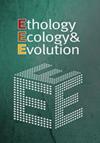栖息于大西洋森林凤梨属植物的青蛙的食植物性消耗
IF 1.1
4区 生物学
Q4 BEHAVIORAL SCIENCES
引用次数: 1
摘要
对不同栖息地蛙类的饮食分析表明,这些两栖动物主要以节肢动物为食。一般来说,青蛙不是选择性捕食者,但它们的捕获方式可能在主动和被动觅食之间不断变化。在本研究中,我们通过分类和功能鉴定(营养行会)评估了两种凤梨蛙属(= Scinax)的饮食。创新性地利用了蛙类捕食物的营养成分,利用蛙类的植食性消耗作为蛙类偏爱凤梨类的指标。我们还评估了青蛙的大小与它们摄入的猎物的大小之间的潜在关系,消耗率是否随季节变化,以及觅食模式。结果表明,两种Ololygon物种(O. littorea和O. perpusilla)的饮食主要由植食性节肢动物组成。大部分节肢动物为半翅目、双翅目和膜翅目。结果表明,雨季和旱季节肢动物的摄取量差异不显著,个体蛙的体型和相应的猎物摄取量之间也没有显著关系。蛙类的觅食方式仅限于凤梨科植物的营养部分,它们不以任何潜在的传粉媒介为食。综上所述,这些结果表明青蛙可能更喜欢寄主凤梨纲,并表明青蛙、凤梨纲和植食节肢动物之间存在潜在的营养级联。本文章由计算机程序翻译,如有差异,请以英文原文为准。
Phytophagous consumption by frogs inhabiting bromeliads from Atlantic Forest
Analyses of the diets of frog species in a range of different habitats have shown that these amphibians feed primarily on arthropods. In general, frogs are not selective predators, but may vary in their capture mode along a continuum between active and passive foraging. In the present study, we assessed the diet of two bromeliad-breeding frogs of the genus Ololygon (= Scinax) through taxonomic and functional identification (trophic guilds). We innovate in use of trophic guilds of frogs’ preys and use the phytophagous consumption as proxy for favoring bromeliads by frogs. We also assessed the potential relationship between the size of the frogs and that of the prey they ingest, whether consumption rates varied seasonally, and the foraging mode. The results indicated a diet composed predominantly of phytophagous arthropods for both Ololygon species (O. littorea and O. perpusilla). Most of the arthropods consumed belonged to the orders Hemiptera, Diptera and Hymenoptera. We found no significant differences among the number of arthropods ingested in the rainy and in the dry seasons in either Ololygon species, nor significant relationship found between the frog size and corresponding prey ingested by individual frogs. The foraging mode of frogs was restricted only to vegetative parts of bromeliads and they did not feed on any potential pollinators. Taken together, these results suggested that frogs may favor the host bromeliad and suggest a potential trophic cascade among frogs, bromeliads, and phytophagous arthropods.
求助全文
通过发布文献求助,成功后即可免费获取论文全文。
去求助
来源期刊

Ethology Ecology & Evolution
生物-动物学
CiteScore
3.10
自引率
0.00%
发文量
44
审稿时长
>12 weeks
期刊介绍:
Ethology Ecology & Evolution is an international peer reviewed journal which publishes original research and review articles on all aspects of animal behaviour, ecology and evolution. Articles should emphasise the significance of the research for understanding the function, ecology, evolution or genetics of behaviour. Contributions are also sought on aspects of ethology, ecology, evolution and genetics relevant to conservation.
Research articles may be in the form of full length papers or short research reports. The Editor encourages the submission of short papers containing critical discussion of current issues in all the above areas. Monograph-length manuscripts on topics of major interest, as well as descriptions of new methods are welcome. A Forum, Letters to Editor and Book Reviews are also included. Special Issues are also occasionally published.
 求助内容:
求助内容: 应助结果提醒方式:
应助结果提醒方式:


